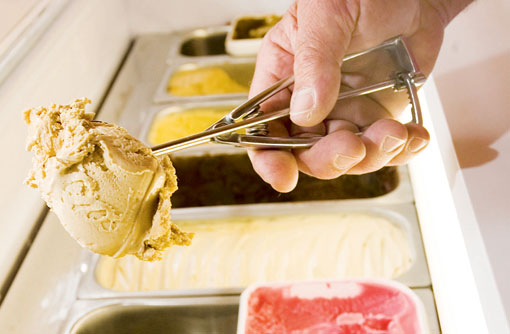Ice cream makers go from cow to cone

Almost 20 years ago, when Peter Walling started making ice cream on the family’s dairy farm in Lancashire, it was considered a bold move.
Consumer interest in locally produced food was barely stirring, while ice cream making was still in the hands of the big national companies and a handful of smaller, but long-established businesses with no farming connections. At that time, farmers who turned their milk into ice cream were a rarity.
But determined to minimise the impact of the newly imposed milk quotas – coupled with some basic knowledge of milk processing and a dash of entrepreneurial risk-taking – was enough to encourage Mr Walling to undertake a modest investment in equipment and start making ice cream on a small scale at the family’s farm at Cockerham, near Lancaster.
“Interest in local food and for farmers to actually retail what they produced from the farm was still very novel in the mid-1980s. But we took the plunge and produced our first batch of ice cream on a wet day in May in the middle of silage making. The silage contractor was our first official taster. He gave it the thumbs up and that was the start of Wallings Ice Cream,” says Mr Walling.
Sold from the farm “through a hatch in a wooden building”, the consumers of 20 years ago were happy with a handful of basic flavours. Now the Walling family produces nearly 40 different flavours of ice cream – and is always willing to try making new ones at a customer’s request.
The first ice cream was produced from milk from the family’s 80-cow Friesian herd but now, although the business continues to expand, the herd has been reduced to 40 milkers.
“I suppose we could sell the herd and buy-in the milk, but the cows and the milk they produce from this good-grass growing area are at the heart of the provenance of our ice cream. We don’t push the cows hard for high yields and we use very little fertiliser. The aim is to produce milk of high quality based on the management and welfare of the herd and how we farm the land.
“And at a time when the public is becoming evermore aware of how their food is produced, taking the responsibility for producing our basic raw materials of milk and cream is a major asset to the business and the image of the product.”
Local stockist
Regional supermarket chain Booths responded positively to an approach from the Walling family to stock its ice cream. But the move into the “real world” of the retail food market came at a time when the passion for eating ice cream was forging ahead.
“Ice cream came of age almost overnight in terms of its appeal, its taste and its favours – and certainly showed what consumers were prepared to pay for a high quality food product. All at once ice cream was sexy,” says Mr Walling.
Until seven years ago, the Walling family continued to sell ice cream through the hatch on the farm that lies close to Morecambe Bay and the west Lancashire coast. But 2005 saw the opening of “The Pudding House” – a restaurant incorporating an ice cream shop situated on the farm. It was a major investment for the family, but it has led to further expansion of the ice cream business.
The family farm is still the headquarters of the business and all ice cream is still produced there by a dedicated team of staff. Today, Wallings Ice Cream is also sold to other farm shops and independent retail outlets.
Open every day of the year except Christmas Day and Boxing Day, the Pudding House is now a Mecca for ice cream lovers. “Even on a real dog-of-a-day in the winter we have regular customers. Ice cream is nothing like it was 40 years ago, but this has also become a very competitive market and you have to maintain high standards at every stage.”
Mr Walling is at the helm of the ice cream side of the business and now his three children – Robert, Philip and Anna – are also involved, while his brother Allan runs the dairy herd and the farm’s other livestock.
But making and retailing ice cream is a high-risk business. “Ice cream is classed as a high-risk food product because it’s the result of a food-making process and yet it’s a food eaten without any cooking. So all stages of making ice cream have strict regulations to ensure the highest standards of hygiene are maintained.
“While producing ice cream may seem a very straightforward business to move into if you’ve got the milk to make it, it’s a venture that’s a bit like an iceberg – there’s a lot more to it than you can actually see.”
Keep up to date with the latest on Livestock 2013
